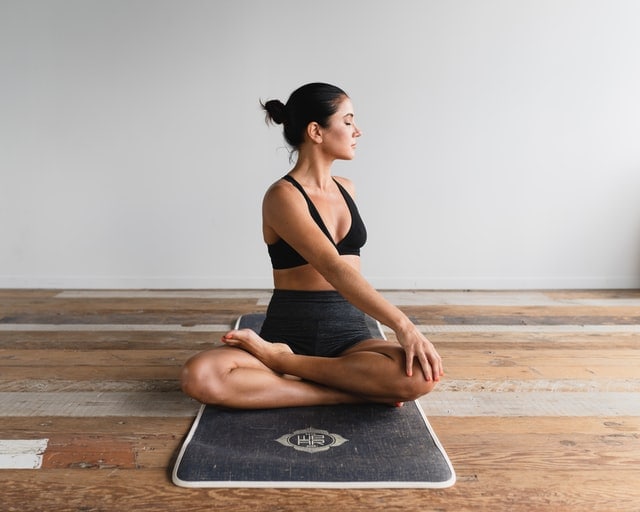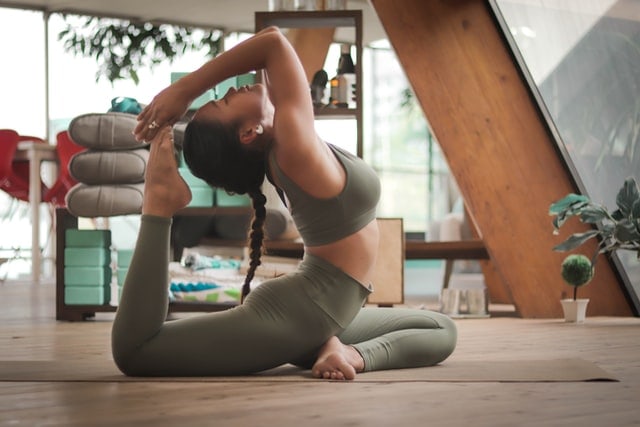Yoga for beginners: Learn about the do’s and dont’s, truths and myths about Yoga
“Yoga is not about touching your toes, it’s about what you learn on the way down.”
– Jigar Gor (International Yoga & Ayurveda Consultant)
Namaste! Doesn’t it seem like everyone is talking about practising yoga and how they can’t live without their daily or weekly class? Even pregnant women are taking prenatal yoga classes. But if you’re a beginner, attending your first class can sometimes be overwhelming! It certainly was for me! But don’t worry if you’re nervous about your stepping onto the mat for the first time, we’re about to cover all you need to know about yoga for beginners.

Three benefits of yoga for beginners
Yoga offers many advantages for your physical and mental health. It is a comprehensive fitness practice that provides holistic wellness as well as helping to improve your fitness levels.
1. Physical strength and flexibility
With regular yoga practice, your body becomes stronger and more flexible. Your joints and muscles will be toned and better able to support your daily activities. A simple how-to yoga for beginners will show a marked reduction in discomfort. For example, if you have a chronic bad back, try yoga for back pain from the comfort of your own bed.
2. Internal health
There are hundreds of yoga poses that work on more levels than just the muscular. Many poses stimulate the internal organs of the body to make them function more effectively and to reduce visceral fat. Problems related to the digestion and elimination functions – like acidity, constipation, Irritable Bowel Syndrome, etc. – can benefit from targeted sessions on yoga for beginners.
3. Mental health
Yoga creates a link between physical and mental well-being and can offer even beginners the special benefits of calming anxiety and reducing stress. Even the most basic poses in your first how-to yoga for beginners will teach you how to control breathing and focus inwards. This skill can be applied to your daily life too, whether you are at work, stuck in traffic, or lying on the beach. A short breathing exercise can calm and centre you immediately.

Whether you’re worried about Bikram Yoga or Kundalini Yoga, there is a form of yoga for you. Find out which of the yoga types is right for you.
Truths and myths about yoga
Some misconceptions about yoga may get in the way of your journey to wellness. Here are three common ones for you to overcome.
- Yoga is not linked to a religious belief system. Yoga is a holistic practice that elevates your body, mind and soul. It originated in India but has been adopted by the world as a well-being practice that is very relevant in the modern world.
- Yoga is not meant only for young, thin, or flexible people. Whether you can touch your toes or not, yoga is for everyone. There are stretches for flexibility that you can do if you want to improve your ability to bend and move. However, do note that if you have existing health conditions like vertigo, high blood pressure, or bone problems, there may be some restrictions with the poses you can do. If you are pregnant or have just had surgery, there may also be certain poses that are not suitable for you.
- Yoga is for everyone, whether you are already about to retire or just starting your first job, and whether you are underweight or overweight. You can practice it regardless of race or gender and regardless of what sport you already practice. If you are a runner, a footballer, or a weightlifter, an easy session of how-to yoga for beginners can help improve your performance and your stamina or even help you unwind after a long day.
The simple truth about yoga is this: it is one of the most gentle ways to strengthen yourself, both physically and emotionally.
Simple yoga asanas for beginners

Asanas are the building blocks of yoga. They are poses that are designed to create peace of mind and body. When done correctly, these asanas help relax your body, improve your mental health, detox and destress after a stressful time, increase mental clarity and productivity, and build a strong core that supports your body. You can even do yoga for weight loss but you should know that the results take much longer to be apparent. If you want to get started, here is a short workout that you can do at home.
Simple breathing exercises – how to yoga for beginners
The benefit of yoga is that it can be done anywhere and without any equipment except your mat. You can even do yoga in bed without a mat, to sleep better. But whether you are trained or a complete beginner, there are simple breathing exercises that you can do at home, in the morning, at night, or at work.
The most popular type of breathing is Prayanama. These yoga breathing exercises are easy to learn and practice but do remember that you should do this on an empty stomach. It is best that you do this in the fresh air and not in air-conditioned spaces.
The word comes from a combination of two words: Prana means the life force in the body, and ayama means to lengthen.
Prana flows through the body and when it is smooth, you feel happy, creative and positive. When the flow is blocked, jerky or stagnated at different spots in the body, you may feel tense, sluggish, and negative.

There are different types of pranayama: Bhramari, Kapal Bhati, Bhastrika, and Nadi Shodhan. Some of these forms involve rapid breathing and abdominal movements so are not recommended for those with asthma, heart or respiratory conditions, or if you have your period or are pregnant.
If you are a beginner, try this exercise instead: Close your eyes and sit in an upright position. You can sit cross-legged if this is comfortable, or in a chair. Take a deep breath in and let it out slowly. As you do this, focus on the breath entering your body and exiting it. Do this for ten breaths and see how you feel.
You might also like to try this simple guided meditation to help you start your day.
Yoga for Beginners – Do’s & Don’ts:
As a beginner, there are many ways to help you improve your yoga journey.
- Don’t eat a heavy meal before a yoga class. Practicing yoga on a full stomach may lead to discomfort, nausea or even vomiting. Eat a light meal – a bowl of fruit, cooked oatmeal, or a couple of slices of toast – at least 20 minutes before your class.
- Choose healthy snacks during the day to fuel your body with the energy it needs after a workout.
- Keep a bottle of water and a fresh face towel at hand for your practice. It helps to take small sips during your class and a face towel is always handy for drying off perspiring hands or forearms.
- Do invest in your own yoga mat and wear comfortable clothing that isn’t restrictive in any way. Make sure you practice yoga on level flooring.
- Don’t push it. Yoga for beginners is a journey. Unlike personal training or outdoor group fitness, yoga won’t work if you strain yourself too much. All your movements should be unhurried and rhythmic. Also, refrain from rigorous workout sessions after practicing yoga.
Yoga is a personal journey
Starting yoga can be intimidating, but it’s always easier if you have the right teacher to guide you along the way. A very important part of yoga practice is your instructor. While online yoga studios can help to a certain level, it is always advisable to take lessons from a knowledgeable practitioner (yogi) at a yoga studio near you.

To make your yoga journey a holistic one, you must begin with no expectations. Simply show up for the class with an open mind and a focus to be healthy (in your mind and body). You may not get the postures right or achieve the asanas exactly the way the teacher demonstrates. But just remember that yoga is a personal journey. You will get to your intended destination, so just be patient.
It is important that you listen to your body. Yoga is not a practice that comes with the label of ‘one size fits all’. Most knowledgeable teachers offer modifications according to your body, your flexibility, and any health conditions you may have. All you need to do is show up, practice with intent, and respect the limitations of your body.
If you’re thinking, “Where can I find classes for yoga near me?” Avaana can help. It is important that you find the right group of people to support you. Whether you are on the mat or off it, yoga is a spiritual practice. Do try to find a community that is inclusive, supportive and positive.
Whether you follow your teacher’s guidelines in yoga for beginners or follow your heart, yoga can open the door to a happy, healthy and stress-free life. So namaste to you!



